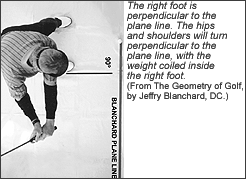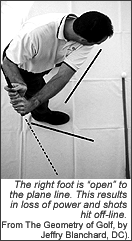Spearheaded by burgeoning scientific and clinical research literature, psychedelics have reached a level of media coverage and popular interest that has not been seen for over half a century. By “psychedelics,” we are referring to the unique class of substances that includes psilocybin (the active compound found in so-called “magic mushrooms”), LSD, dimethyltryptamine (DMT), ayahuasca, 5-MeO-DMT, and mescaline – each of which occurs in the natural world (except for LSD, which is a semi-synthetic compound).
Chiropractic and Golf, Part 7
Leg Drive - The Backswing
Golfers are often told how important it is to use the legs when driving a golf ball. The benefit of leg drive is the production of long and powerful shots. However, if you ask the average golfer how to engage the legs in the golf swing, you rarely receive a definitive answer. There are two components to the leg drive: the backswing, which generates the kinetic energy; and the downswing, which releases the kinetic energy. This article will address the backswing, focusing on the right-handed golfer.


Positioning the Right Foot
Before swinging the club, the right foot must be positioned perpendicular to the imaginary plane line that extends from the golf ball to 10 feet behind the golf ball. When the right foot is perpendicular to the plane line, the hips and shoulders will coil rapidly, generating kinetic energy, or power. When the right foot is "open" to the plane line, there is a loss of that energy, and shots hit off-line.
Have you ever wondered why, in professional baseball, the pitcher's "rubber" or step-off surface is placed parallel to the leading edge of home plate? It's done so the pitcher can place his back foot parallel to the target. During the windup, he will pivot his hips and shoulders around his back leg, until they are perpendicular to the target. If he's a right-hander, he'll keep his weight coiled inside the right foot, then release the stored kinetic energy with a perpendicular push off the rubber toward home plate.
When swinging the golf club, the hips and shoulders start parallel to the plane line when addressing the ball. At the top of the backswing, the hips and shoulders are perpendicular to the plane line. When the right foot is perpendicular to the plane line, the golfer can drive his or her legs parallel to the plane line and directly toward the chosen target.
Flex of the Right Knee
It's important that the golfer's torso does not float upward during the backswing. The torso will float upward if the back leg straightens out during the backswing. If your patient is straightening the back leg, he or she is likely to hit just behind the ball "fat" on the downswing.
Clinical Examination
Right foot: Place a golf ball on the floor. Place a strip of tape under the ball, extending to 10 feet behind the ball. The tape is the plane line. Ask your patient to set up over the ball at the address position. Note the position of the right foot; it should be perpendicular to the plane line.
Flex of right knee: Have the patient swing the club to the top of the backswing, and stop. Observe the flex of the right knee. If the knee was flexed at address, then straightened at the top of the backswing, the torso will have elevated. Take a second look at the backswing, and watch the movement of the left foot. If the patient has to move up onto the toes, there is poor flexibility for golf in the lower leg.


Correction Protocol
Open the right foot: Ask the patient to point the right foot directly at the plane line. Note that the patient may have the right foot "open" and feel restricted in the ability to turn the hips otherwise. Check for ilium and/or SI joint subluxation. Another possible cause of the restricted hip turn could be that the rotators of the hip girdle are too tight. In either case, the problem can be corrected with spinal adjustments and muscle-specific stretching in the hips.
Straightening the right knee: Check the flexibility of the gastrocnemius and soleus. Have the patient work on lengthening these muscles until he or she can avoid lifting up onto the toes during the backswing.
Jeffry Blanchard, DC
Encinitas, California
jhbdcpga@aol.com
www.blanchardgolf.com



